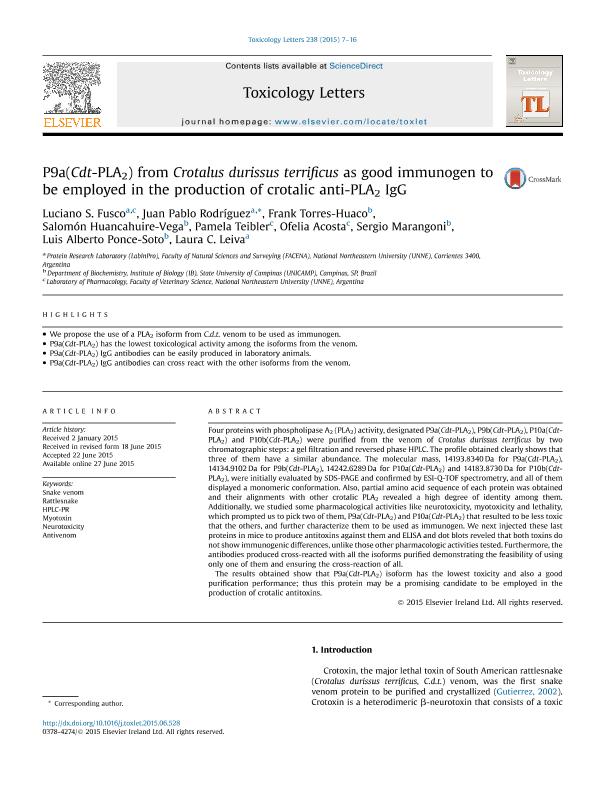Mostrar el registro sencillo del ítem
dc.contributor.author
Fusco, Luciano Sebastian

dc.contributor.author
Rodríguez, Juan Pablo

dc.contributor.author
Torres Huaco, Frank
dc.contributor.author
Huancahuire Vega, Salomón
dc.contributor.author
Teibler, Gladys Pamela

dc.contributor.author
Acosta, Ofelia Cristina

dc.contributor.author
Marangoni, Sergio
dc.contributor.author
Ponce Soto, Luis
dc.contributor.author
Leiva, Laura Cristina Ana

dc.date.available
2018-02-28T19:36:27Z
dc.date.issued
2015-10
dc.identifier.citation
Fusco, Luciano Sebastian; Rodríguez, Juan Pablo; Torres Huaco, Frank; Huancahuire Vega, Salomón; Teibler, Gladys Pamela; et al.; P9a(Cdt-PLA2) from Crotalus durissus terrificus as good immunogen to be employed in the production of crotalic anti-PLA2 IgG; Elsevier Ireland; Toxicology Letters; 238; 1; 10-2015; 7-16
dc.identifier.issn
0378-4274
dc.identifier.uri
http://hdl.handle.net/11336/37476
dc.description.abstract
Four proteins with phospholipase A2 (PLA2) activity, designated P9a(Cdt-PLA2), P9b(Cdt-PLA2), P10a(Cdt-PLA2) and P10b(Cdt-PLA2) were purified from the venom of Crotalus durissus terrificus by two chromatographic steps: a gel filtration and reversed phase HPLC. The profile obtained clearly shows that three of them have a similar abundance. The molecular mass, 14193.8340Da for P9a(Cdt-PLA2), 14134.9102Da for P9b(Cdt-PLA2), 14242.6289Da for P10a(Cdt-PLA2) and 14183.8730Da for P10b(Cdt-PLA2), were initially evaluated by SDS-PAGE and confirmed by ESI-Q-TOF spectrometry, and all of them displayed a monomeric conformation. Also, partial amino acid sequence of each protein was obtained and their alignments with other crotalic PLA2 revealed a high degree of identity among them. Additionally, we studied some pharmacological activities like neurotoxicity, myotoxicity and lethality, which prompted us to pick two of them, P9a(Cdt-PLA2) and P10a(Cdt-PLA2) that resulted to be less toxic that the others, and further characterize them to be used as immunogen. We next injected these last proteins in mice to produce antitoxins against them and ELISA and dot blots reveled that both toxins do not show immunogenic differences, unlike those other pharmacologic activities tested. Furthermore, the antibodies produced cross-reacted with all the isoforms purified demonstrating the feasibility of using only one of them and ensuring the cross-reaction of all.The results obtained show that P9a(Cdt-PLA2) isoform has the lowest toxicity and also a good purification performance; thus this protein may be a promising candidate to be employed in the production of crotalic antitoxins.
dc.format
application/pdf
dc.language.iso
eng
dc.publisher
Elsevier Ireland

dc.rights
info:eu-repo/semantics/openAccess
dc.rights.uri
https://creativecommons.org/licenses/by-nc-sa/2.5/ar/
dc.subject
Antivenom
dc.subject
Hplc-Pr
dc.subject
Myotoxin
dc.subject
Neurotoxicity
dc.subject
Rattlesnake
dc.subject
Snake Venom
dc.subject.classification
Otras Ciencias Biológicas

dc.subject.classification
Ciencias Biológicas

dc.subject.classification
CIENCIAS NATURALES Y EXACTAS

dc.title
P9a(Cdt-PLA2) from Crotalus durissus terrificus as good immunogen to be employed in the production of crotalic anti-PLA2 IgG
dc.type
info:eu-repo/semantics/article
dc.type
info:ar-repo/semantics/artículo
dc.type
info:eu-repo/semantics/publishedVersion
dc.date.updated
2018-02-22T21:06:07Z
dc.identifier.eissn
1879-3169
dc.journal.volume
238
dc.journal.number
1
dc.journal.pagination
7-16
dc.journal.pais
Irlanda

dc.description.fil
Fil: Fusco, Luciano Sebastian. Universidad Nacional del Nordeste. Facultad de Cs.exactas Naturales y Agrimensura. Departamento de Bioquímica. Laboratorio de Investigación En Proteinas; Argentina. Consejo Nacional de Investigaciones Científicas y Técnicas; Argentina
dc.description.fil
Fil: Rodríguez, Juan Pablo. Universidad Nacional del Nordeste. Facultad de Cs.exactas Naturales y Agrimensura. Departamento de Bioquímica. Laboratorio de Investigación En Proteinas; Argentina. Consejo Nacional de Investigaciones Científicas y Técnicas; Argentina
dc.description.fil
Fil: Torres Huaco, Frank. Universidade Estadual Do Campinas. Instituto de Biología; Brasil
dc.description.fil
Fil: Huancahuire Vega, Salomón. Universidade Estadual Do Campinas. Instituto de Biología; Brasil
dc.description.fil
Fil: Teibler, Gladys Pamela. Universidad Nacional del Nordeste. Facultad de Cs.veterinarias. Departamento de Clinica. Cátedra de Farmacología; Argentina
dc.description.fil
Fil: Acosta, Ofelia Cristina. Universidad Nacional del Nordeste. Facultad de Cs.veterinarias. Departamento de Clinica. Cátedra de Farmacología; Argentina. Consejo Nacional de Investigaciones Científicas y Técnicas; Argentina
dc.description.fil
Fil: Marangoni, Sergio. Universidade Estadual Do Campinas. Instituto de Biología; Brasil
dc.description.fil
Fil: Ponce Soto, Luis. Universidade Estadual Do Campinas. Instituto de Biología; Brasil
dc.description.fil
Fil: Leiva, Laura Cristina Ana. Universidad Nacional del Nordeste. Facultad de Cs.exactas Naturales y Agrimensura. Departamento de Bioquímica. Laboratorio de Investigación En Proteinas; Argentina
dc.journal.title
Toxicology Letters

dc.relation.alternativeid
info:eu-repo/semantics/altIdentifier/url/http://www.sciencedirect.com/science/article/pii/S0378427415300023
dc.relation.alternativeid
info:eu-repo/semantics/altIdentifier/doi/https://doi.org/10.1016/j.toxlet.2015.06.528
Archivos asociados
